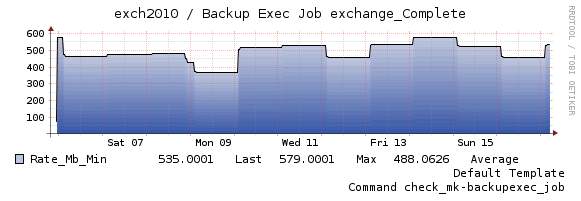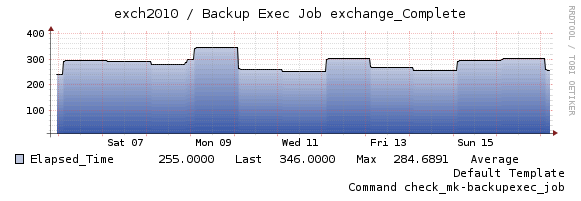This check_mk plugin queries Backup Exec database to find job history, and returns the state of the last job execution.
It has been tested with Backup Exec 2010 and 2012, and should work with previous versions from 9.0 to 12.5. Backup Exec 2010 is required (see below)
It has been tested on Windows 2008 R2, and should work on Windows 2012, and maybe Windows 2003 if powershell is installed.
Contrary to many Backup Exec plugins for Nagios, it is not a compiled executable but a simple powershell script, and doesn’t parse xml history files and so runs very fast.
It tries to connect on the local MSSQL instance named BEDB, which is the default configuration. In most cases, no configuration is needed, just copy backupexec_job.ps1 into check_mk « plugins » subdirectory.
The following performance data is returned to create graphs: Job size, duration, rate and deduplication ratio.
Download from Check-MK Exchange
16/07/2014 : Version 1.1 – Added support for job status 9 (missed)
28/07/2014 : Version 1.2 – Added WATO plugin to treat jobs ‘completed with exceptions’ as OK
29/07/2014 : Version 1.3 – Added support for job status 21 (canceled, timed out)
02/04/2015 : For Backup Exec 12.5, you need to use backupexec_9-12.5_job on your windows server (thanks Guillermo).
25/06/2015 : Version 1.4 – Fixed error « “Check parameter definition for backupexec_job has type Dictionary, but match_type None” » with check_mk 1.2.7i (thanks Jörg !). Version 1.4 doesn’t work anymore with 1.2.6 or previous versions. Use backupexec_job-1.3 instead.
02/09/2015 : Version 1.5 – Fixed compatibility with both check_mk<=1.2.6 and check.mk>=1.2.5 (thanks Peter & François)
07/10/2015 : Version 1.6 – Fixed « ERROR: Skipping invalid manpage: backupexec_job (Catalog info missing) » in 1.2.7i3 (thanks to Daniel Müller)




